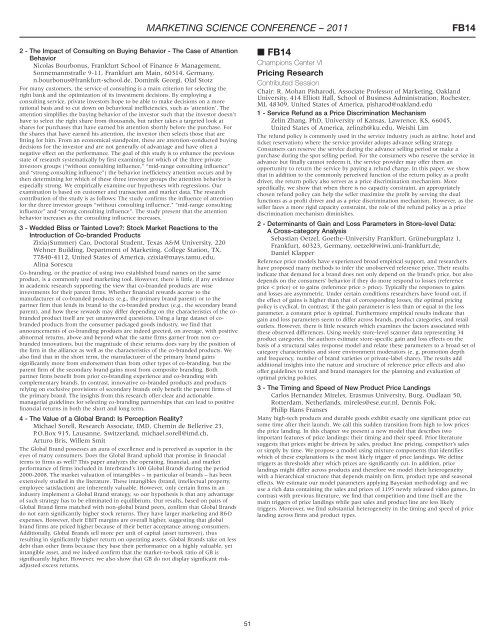Conference Sessions - Jesse H. Jones Graduate School of ...
Conference Sessions - Jesse H. Jones Graduate School of ...
Conference Sessions - Jesse H. Jones Graduate School of ...
You also want an ePaper? Increase the reach of your titles
YUMPU automatically turns print PDFs into web optimized ePapers that Google loves.
2 - The Impact <strong>of</strong> Consulting on Buying Behavior - The Case <strong>of</strong> Attention<br />
Behavior<br />
Nicolas Bourbonus, Frankfurt <strong>School</strong> <strong>of</strong> Finance & Management,<br />
Sonnemannstrafle 9-11, Frankfurt am Main, 60314, Germany,<br />
n.bourbonus@frankfurt-school.de, Dominik Georgi, Olaf Stotz<br />
For many customers, the service <strong>of</strong> consulting is a main criterion for selecting the<br />
right bank and the optimization <strong>of</strong> its investment decisions. By employing a<br />
consulting service, private investors hope to be able to make decisions on a more<br />
rational basis and to cut down on behavioral inefficiencies, such as ‘attention’. The<br />
attention simplifies the buying behavior <strong>of</strong> the investor such that the investor doesn’t<br />
have to select the right share from thousands, but rather takes a targeted look at<br />
shares for purchases that have earned his attention shortly before the purchase. For<br />
the shares that have earned his attention, the investor then selects those that are<br />
fitting for him. From an economical standpoint, these are attention-conducted buying<br />
decisions for the investor and are not generally <strong>of</strong> advantage and have <strong>of</strong>ten a<br />
negative effect on the performance. The goal <strong>of</strong> this study is to enhance the previous<br />
state <strong>of</strong> research systematically by first examining for which <strong>of</strong> the three private<br />
investors groups (“without consulting influence,” “mid-range consulting influence”<br />
and “strong consulting influence”) the behavior inefficiency attention occurs and by<br />
then determining for which <strong>of</strong> these three investor groups the attention behavior is<br />
especially strong. We empirically examine our hypotheses with regressions. Our<br />
examination is based on customer and transaction and market data. The research<br />
contribution <strong>of</strong> the study is as follows: The study confirms the influence <strong>of</strong> attention<br />
for the three investor groups “without consulting influence,” “mid-range consulting<br />
influence” and “strong consulting influence”. The study present that the attention<br />
behavior increases as the consulting influence increases.<br />
3 - Wedded Bliss or Tainted Love?: Stock Market Reactions to the<br />
Introduction <strong>of</strong> Co-branded Products<br />
Zixia(Summer) Cao, Doctoral Student, Texas A&M University, 220<br />
Wehner Building, Department <strong>of</strong> Marketing, College Station, TX,<br />
77840-4112, United States <strong>of</strong> America, czixia@mays.tamu.edu,<br />
Alina Sorescu<br />
Co-branding, or the practice <strong>of</strong> using two established brand names on the same<br />
product, is a commonly used marketing tool. However, there is little, if any evidence<br />
in academic research supporting the view that co-branded products are wise<br />
investments for their parent firms. Whether financial rewards accrue to the<br />
manufacturer <strong>of</strong> co-branded products (e.g., the primary brand parent) or to the<br />
partner firm that lends its brand to the co-branded product (e.g., the secondary brand<br />
parent), and how these rewards may differ depending on the characteristics <strong>of</strong> the cobranded<br />
product itself are yet unanswered questions. Using a large dataset <strong>of</strong> cobranded<br />
products from the consumer packaged goods industry, we find that<br />
announcements <strong>of</strong> co-branding products are indeed greeted, on average, with positive<br />
abnormal returns, above and beyond what the same firms garner from non cobranded<br />
innovations, but the magnitude <strong>of</strong> these returns does vary by the position <strong>of</strong><br />
the firm in the alliance as well as the characteristics <strong>of</strong> the co-branded products. We<br />
also find that in the short term, the manufacturer <strong>of</strong> the primary brand gains<br />
significantly more from endorsement than from other types <strong>of</strong> co-branding, but the<br />
parent firm <strong>of</strong> the secondary brand gains most from composite branding. Both<br />
partner firms benefit from prior co-branding experience and co-branding with<br />
complementary brands. In contrast, innovative co-branded products and products<br />
relying on exclusive provisions <strong>of</strong> secondary brands only benefit the parent firms <strong>of</strong><br />
the primary brand. The insights from this research <strong>of</strong>fer clear and actionable<br />
managerial guidelines for selecting co-branding partnerships that can lead to positive<br />
financial returns in both the short and long term.<br />
4 - The Value <strong>of</strong> a Global Brand: Is Perception Reality?<br />
Michael Sorell, Research Associate, IMD, Chemin de Bellerive 23,<br />
P.O.Box 915, Lausanne, Switzerland, michael.sorell@imd.ch,<br />
Arturo Bris, Willem Smit<br />
The Global Brand possesses an aura <strong>of</strong> excellence and is perceived as superior in the<br />
eyes <strong>of</strong> many consumers. Does the Global Brand uphold that promise in financial<br />
terms to firms as well? This paper analyzes the operating, financial, and market<br />
performance <strong>of</strong> firms included in Interbrand’s 100 Global Brands during the period<br />
2000-2008. The market valuation <strong>of</strong> intangibles – in particular <strong>of</strong> brands – has been<br />
extensively studied in the literature. These intangibles (brand, intellectual property,<br />
employee satisfaction) are inherently valuable. However, only certain firms in an<br />
industry implement a Global Brand strategy, so our hypothesis is that any advantage<br />
<strong>of</strong> such strategy has to be eliminated in equilibrium. Our results, based on pairs <strong>of</strong><br />
Global Brand firms matched with non-global brand peers, confirm that Global Brands<br />
do not earn significantly higher stock returns. They have larger marketing and R&D<br />
expenses. However, their EBIT margins are overall higher, suggesting that global<br />
brand firms are priced higher because <strong>of</strong> their better acceptance among consumers.<br />
Additionally, Global Brands sell more per unit <strong>of</strong> capital (asset turnover), thus<br />
resulting in significantly higher return on operating assets. Global Brands take on less<br />
debt than other firms because they base their performance on a highly valuable, yet<br />
intangible asset, and we indeed confirm that the market-to-book ratio <strong>of</strong> GB is<br />
significantly higher. However, we also show that GB do not display significant riskadjusted<br />
excess returns.<br />
MARKETING SCIENCE CONFERENCE – 2011 FB14<br />
51<br />
■ FB14<br />
Champions Center VI<br />
Pricing Research<br />
Contributed Session<br />
Chair: R. Mohan Pisharodi, Associate Pr<strong>of</strong>essor <strong>of</strong> Marketing, Oakland<br />
University, 414 Elliott Hall, <strong>School</strong> <strong>of</strong> Business Administration, Rochester,<br />
MI, 48309, United States <strong>of</strong> America, pisharod@oakland.edu<br />
1 - Service Refund as a Price Discrimination Mechanism<br />
Zelin Zhang, PhD, University <strong>of</strong> Kansas, Lawrence, KS, 66045,<br />
United States <strong>of</strong> America, zelinzh@ku.edu, Weishi Lim<br />
The refund policy is commonly used in the service industry (such as airline, hotel and<br />
ticket reservation) where the service provider adopts advance selling strategy.<br />
Consumers can reserve the service during the advance selling period or make a<br />
purchase during the spot selling period. For the consumers who reserve the service in<br />
advance but finally cannot redeem it, the service provider may <strong>of</strong>fer them an<br />
opportunity to return the service by paying a refund charge. In this paper, we show<br />
that in addition to the commonly perceived function <strong>of</strong> the return policy as a pr<strong>of</strong>it<br />
driver, the return policy also serves as a price discrimination mechanism. More<br />
specifically, we show that when there is no capacity constraint, an appropriately<br />
chosen refund policy can help the seller maximize the pr<strong>of</strong>it by serving the dual<br />
functions as a pr<strong>of</strong>it driver and as a price discrimination mechanism. However, as the<br />
seller faces a more rigid capacity constraint, the role <strong>of</strong> the refund policy as a price<br />
discrimination mechanism diminishes.<br />
2 - Determinants <strong>of</strong> Gain and Loss Parameters in Store-level Data:<br />
A Cross-category Analysis<br />
Sebastian Oetzel, Goethe-University Frankfurt, Grüneburgplatz 1,<br />
Frankfurt, 60323, Germany, oetzel@wiwi.uni-frankfurt.de,<br />
Daniel Klapper<br />
Reference price models have experienced broad empirical support, and researchers<br />
have proposed many methods to infer the unobserved reference price. Their results<br />
indicate that demand for a brand does not only depend on the brand’s price, but also<br />
depends on the consumers’ behavior if they do more respond to losses (reference<br />
price < price) or to gains (reference price > price). Typically the responses to gains<br />
and losses are asymmetric. Under certain conditions researchers have found out, if<br />
the effect <strong>of</strong> gains is higher than that <strong>of</strong> corresponding losses, the optimal pricing<br />
policy is cyclical. In contrast, if the gain parameter is less than or equal to the loss<br />
parameter, a constant price is optimal. Furthermore empirical results indicate that<br />
gain and loss parameters seem to differ across brands, product categories, and retail<br />
outlets. However, there is little research which examines the factors associated with<br />
these observed differences. Using weekly store-level scanner data representing 34<br />
product categories, the authors estimate store-specific gain and loss effects on the<br />
basis <strong>of</strong> a structural sales response model and relate these parameters to a broad set <strong>of</strong><br />
category characteristics and store environment moderators (e. g. promotion depth<br />
and frequency, number <strong>of</strong> brand varieties or private-label share). The results add<br />
additional insights into the nature and structure <strong>of</strong> reference price effects and also<br />
<strong>of</strong>fer guidelines to retail and brand managers for the planning and evaluation <strong>of</strong><br />
optimal pricing policies.<br />
3 - The Timing and Speed <strong>of</strong> New Product Price Landings<br />
Carlos Hernandez Mireles, Erasmus University, Burg. Oudlaan 50,<br />
Rotterdam, Netherlands, mireles@ese.eur.nl, Dennis Fok,<br />
Philip Hans Franses<br />
Many high-tech products and durable goods exhibit exactly one significant price cut<br />
some time after their launch. We call this sudden transition from high to low prices<br />
the price landing. In this chapter we present a new model that describes two<br />
important features <strong>of</strong> price landings: their timing and their speed. Prior literature<br />
suggests that prices might be driven by sales, product line pricing, competitor’s sales<br />
or simply by time. We propose a model using mixture components that identifies<br />
which <strong>of</strong> these explanations is the most likely trigger <strong>of</strong> price landings. We define<br />
triggers as thresholds after which prices are significantly cut. In addition, price<br />
landings might differ across products and therefore we model their heterogeneity<br />
with a hierarchical structure that depends mainly on firm, product type and seasonal<br />
effects. We estimate our model parameters applying Bayesian methodology and we<br />
use a rich data containing the sales and prices <strong>of</strong> 1195 newly released video games. In<br />
contrast with previous literature, we find that competition and time itself are the<br />
main triggers <strong>of</strong> price landings while past sales and product line are less likely<br />
triggers. Moreover, we find substantial heterogeneity in the timing and speed <strong>of</strong> price<br />
landing across firms and product types.

















